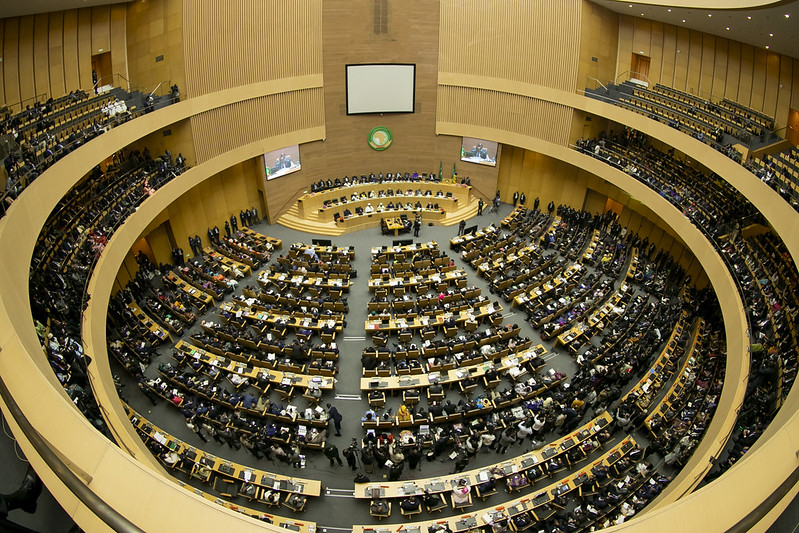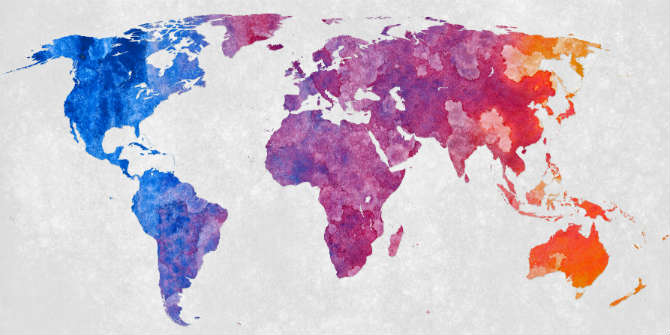LSE PfAL Fellow Scott Firsing argues that aerospace technology is the way forward for many African countries.
Mobile phones revolutionised Africa. From the simple ability to communicate or to access the Internet or online banking, today most Africans cannot function without one or more mobile devices.
The majority of this access comes from satellites. In fact, I am writing this article from South Africa accessing the Internet using 3G via satellite. Satellites are an indispensable part of an almost unthinkable number of equations. However, despite the benefits that mobile phones have brought to Africa, most do not realise or comprehend what satellites and other aerospace technology can truly do to transform the African continent.

Information from satellites was once the backbone of the United States (US) military and intelligence community and still is a large part of their ‘staple’ diet. Having access to imagery around the world and other services satellites provide information on terror groups, humanitarian disasters and everything in between.
The US has used these satellites over Africa, but so have other entities like IGOs, and NGOs. Satellite imagery has provided evidence of human rights abuses in countries like Central African Republic, Libya, and Sudan. In fact, Earth Observation (EO), geographic information systems (GIS), global position systems (GPS) and remote sensing satellites have been used over Africa for a variety of reasons, all of which have contributed to human security and justice.
Satellite images taken over Zimbabwe in 2005 revealed the truth behind the complete destruction and forced relocation of a settlement that once housed almost 10,000 people outside Harare. This government-led operation known as Operation Murambatsvina, originally denied by the Zimbabwean government, was part of a plan of mass forced eviction by demolishing homes and businesses and forcibly relocating the urban poor to more rural areas.
Currently no African country has the ability to launch their own satellite. If this is their goal, they essentially have two options. They can rely on countries with orbital launch capability like Russia, US, France, Japan, China, India, and others to launch their satellites for them or go through a private launching company. Typically the answer for most developing countries is to use Russia because of their expertise and low costs. Russia recently launched South Africa’s secret Kondor-E satellite in January 2015 that provides all-weather, day-and-night radar imagery for the South African military. All in all, it is an expensive exercise and not many African countries can afford such an endeavour. However, this could possibly change in the near future as technological advancements continue to unfold from private companies like SpaceX and as the continent continues to grow economically.
Often outsiders to Africa are perplexed when they hear of African space agencies or even the thought of an African nation establishing one. Question arises such as why would African countries do this given other major problems such as a lack of infrastructure, and high poverty, crime and unemployment?
The short and simple answer to a question such as this is that investment in space programs are justified by the scientific, technological, industrial and security capabilities that comes with it. Moreover, these investments provide interesting socio-economic returns including increased industrial activity, and cost efficiencies and productivity gains to other fields such as weather forecasting, telemedicine and environmental monitoring.
There is hard evidence to prove this. The OECD in their 2011 Space Economy at a Glance Report concludes that although economic impacts may vary depending on the country and the level of its specialisation, documentation of positive industrial returns from institutional investments in space are growing. They give Norway as an example with their small but active space program. They detected a positive multiplier effect since the 1990s meaning Norwegian space sector companies have on average generated turnover well in excess of the support provided by the European Space Agency or the national investment. The report highlights the following statistics:
– In 2009, 1 million kroner invested provided a return of some 4.7 million.
– In Denmark, each million euro of Danish contributions to ESA has generated a turnover of EUR 3.7 million on average
– In the UK, the space industry’s value-added multiplier has been estimated to be 1.91.
– In the US, a recent Federal Aviation Administration (FAA) study on the economic impacts of the US commercial space activities showed for every dollar spent in commercial space transportation industry between 2002 and 2009, USD 4.9 resulted in indirect and induced economic impact.
Unfortunately many African countries are not at a level to even consider having their own space agency let alone launch capability. However, there is a more cost-effective option whereby a country can sign a contract with a commercial satellite company allowing them access to their satellite. Even the US military, with their huge financial budget and manpower, are looking at new ways of doing business with commercial satellite operators. They recently awarded SES Government Solutions a US$8.2 million contract, which allows them capacity aboard an aging satellite covering western Africa, an area of rising importance in the continent due to deteriorating human security conditions.
African Security Concerns
One of the main concerns for African and international nations in general is the terrorist group Boko Haram which operates in northern Nigeria and as well as neighbouring countries. They have sworn allegiance to both Al-Qaeda and Isis. The Nigerian military is battling to contain the situation on land, but now also has another growing problem off its shores. Maritime piracy in the Gulf of Guinea is increasing and is becoming enmeshed with syndicates linked to international criminal organisations as well as the violent jihadist groups in the Sahel.
Piracy off the East African coast was a hot topic a number of years ago. Thanks to satellite technology and international cooperation, you hardly see this topic in the media anymore. Maritime Domain Awareness or MDA via satellite and land-based systems such as the Space Based Advanced MDA Network (SAMNET) and the Maritime Safety & Security Information System (MSSIS) have given countries the ability to fight piracy and illegal trafficking and protect international trade. This means increased food and energy security and economic growth, all at an economical price. MSSIS, for example, is a freely-shared, unclassified, near real-time data network that allows member countries to share data from Automatic Identification System (AIS), coastal radar, and other maritime-related systems. Participating nations can login to a secure server and access single data stream with a wide range of geographic display options, including text, photo overlays, electronic charts, and even Google Earth. This technology, combined with the success of various task forces such as the European Union’s Operation Atalanta, as well as unprecedented international co-operation between the world’s powers has helped safeguard the sea-lanes around the Horn of Africa.

Nevertheless, there are concerns Western countries and others will not have the political will to repeat these types of operations in West Africa. The waters there are seen as less important compared to the Horn of Africa, which is known as the arteries connecting Europe and Asia through the Suez Canal. Furthermore, years of anti-piracy operations have strained participating countries’ navies.
It is widely believed that the real answer to the problem is a stable government in Somalia with a capable national military or combined African-led force. Whichever it may be, it is clear that they need access to necessary hardware and information via satellites and other aerospace technology like Unmanned Aerial Vehicles (UAVs). The same is to be said of West Africa, where countries are strengthening their coast guards and want to improve information sharing on shipping and attacks.
UAVs or Drone Use in Africa
Western countries like the US have made a big push to assist African countries by utilising their aerospace technology, especially drones. It was revealed in September 2014 that America would soon be opening a new drone base in one of the most remote places on Earth located in Niger. It is the US military’s second surveillance hub in Niger and third in the region, providing the ability to track Islamist fighters who have destabilised parts of North and West Africa. The ultimate goal is to save lives and provide stability for African economies to grow and flourish.
Overall, the use of drones in African conflict areas has grown considerably in recent years, now being used in a number of UN Peacekeeping Operations. The UN has deployed UAVs in the eastern Democratic Republic of Congo (DRC) since January 2013. According to UN commanders, never before have troops been able to collect so much detailed information about people and places of interest such as the locations of illegal gold mines, the exact location of a rebel base, or who is buying and selling weapons.There is also a psychological effect because the subjects are aware of the drones flying overhead gathering surveillance.
Besides the obvious benefits of drones to improved human security in conflict areas, drones may soon be providing economic solutions to African countries via commercial cargo drones, also known as donkeys. The world’s first commercial cargo drone route is set to become operational in Kenya by 2016 alleviating the problems of poor road and railway infrastructure that plagues not only Kenya, but most of the continent.
Drones were recently spotted over Cape Town during a spout of massive wild fires. News24, a South Africa-based news agency, was able to provide a better extent of the fire damage that destroyed nearly 3,000 hectares of vegetation by flying their drone up into the sky over the area.
Drones can provide much needed information about the African environment and more specifically agricultural land. It is estimated that nearly 60% of the world’s arable land is in Africa. However, the African continent is also expected to be one of the hardest hit areas by climate change. It is likely the amount of droughts and/or floods will rise.
As with most new ideas, there are concerns. One main fear is the effect on personal privacy when surveillance drones are acquired and deployed by the state. This is particularly worrying in Africa given the history of human rights abuses by governments. Another concern is the human capital element. Africa has a large youth population, but will there be enough engineers, drone pilots, mechanics to sustain and grow such an industry? Can higher education in Africa play a role in such an expansion?
Despite these concerns, African cities like Cape Town are already putting forth proposals to use drones to assist Metro Police, Disaster Management, Fire and Rescue and Engineering departments. It is argued that the acquisition of drones is a cheaper alternative compared to helicopters for aerial surveillance. The city specifically wants the drones to monitor crime, land occupations, illegal businesses, shack fires and disasters.
South Africans have already been using drones in commercial filming and anti-poaching operations, so why not for other uses as well?
The use of aerospace technology is a hot topic and there will always be debate. However, the ability to improve human and food security and the socio-economic impacts alone should speak volumes. Moreover, due to the an enormous land mass of 11.67 million sq miles (30.2 million sq kms) or the entirety of the US, China, India, Japan and Europe combined, it becomes clear that improved aerospace technology and access to it will provide much more good than harm.
Dr Scott Firsing, a LSE Program for African Leadership (PfAL) Fellow, is the co-founder of the Aerospace Leadership Academy in South Africa and a Research Fellow at Monash University, South Africa. Follow him on Twitter @scottfirsing.
The views expressed in this post are those of the author and in no way reflect those of the Africa at LSE blog or the London School of Economics and Political Science.






1 Comments